The School and the Immigrant
Chapter 2: School Children From Non-English-Speaking Homes
Herbert A. Miller
Table of Contents | Next | Previous
In the course of the Survey an investigation was made to determine the number of children enrolled in the public schools who were from homes in which English is not regularly spoken. Each child in the schools above the kindergarten age was asked to fill out a blank containing two questions: first, "What is the language of your home?" and second, "What language besides English can you read?" It was assumed that "the language of the home" is the one regularly spoken by the child before he goes to school and to a large extent throughout the years he is in school. The results of studies in other cities have shown that "language of the home" is a better index of "foreignness" among school children than is furnished by the deco giving the countries of birth of the parents.
The data were collected from all schools on a single day, and the totals represent the attendance for that clay, not the entire number enrolled in the schools. In all, replies were obtained from 75,046 children in the elementary
(24) schools, and from 9,088 attending the high schools. Almost exactly one-half of the children in the elementary schools came from homes in which English is not regularly spoken. The most important of the foreign languages on the basis of number of children reporting it as their home language was German. Yiddish comes next, with Bohemian third. More than four-fifths of the foreign children were from homes in which either German, Yiddish, Bohemian, Italian, Hungarian, or Polish was spoken. Only four other languages—Slovak, Slovenian, Russian, and Hebrew—were reported by more than one per cent of the foreign pupils. The distribution is shown in detail in Table 1.
It is probable that in many cases the figures are too low. Frequently it was discovered that the children replied "English" when the parents only understood English, but did not speak it. Many foreign children wish to appear "American," even if exact truthfulness suffers in the process. Some were especially reluctant to acknowledge their native language at the present time on account of the European war. In addition there are many who have a speaking knowledge of some foreign language, even when English is commonly used in the home. It is probable that the total number who can speak a language other than English is from five to
( 25)
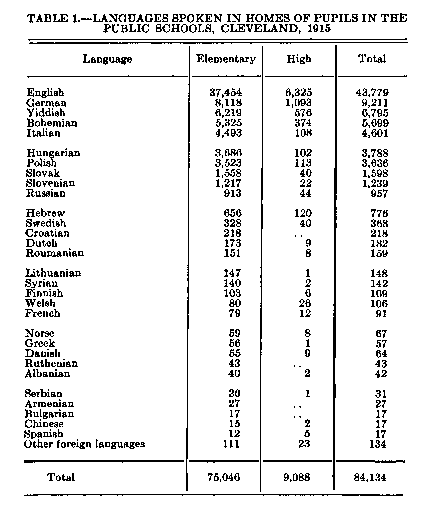
10 per cent greater than the returns obtained show.
The reluctance of the child to confess his foreign origin as he becomes older and more self-conscious is no doubt responsible to some extent for the marked falling off in the upper
(26) grades. This tendency is illustrated in Diagram 5 which shows the number in each grade from English- and from non-English-speaking homes. In the first grade the number of children from homes in which a foreign language is spoken exceeds those from English-speaking homer by nearly 28 per cent. The numerical superiority of the foreign group continues up to the fifth grade, where it drops considerably below the English-speaking group, with a constantly de- creasing ratio up to the eighth grade, in which the children from foreign language homes falls to less than 63 per cent of the number from English-speaking homes.
Although this unfavorable showing is due in some slight degree to inaccuracies in the replies obtained from the children and to the fact that the parents of the older pupils usually have been in this country a considerable time, and therefore are more likely to have learned English, the comparison undoubtedly emphasizes a condition that must be constantly borne in mind in connection with teaching children of foreign parentage. The average child of foreign parentage is not likely to remain in school as long as the average child of native parents, and many of them reach the end of the compulsory attendance period before they have completed the elementary course. During the high school
( 27)
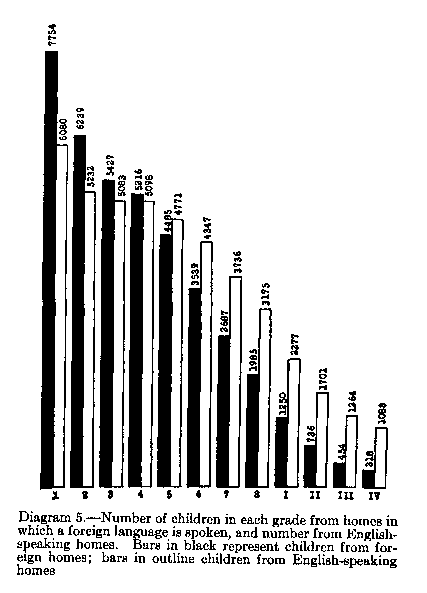
(28) period the tendency of the child of foreign parents to leave school is still more in evidence. By the fourth high school year the number of pupils from homes where a foreign language is spoken is reduced to less than one-third the number from English-speaking families. Not only do fewer pupils from foreign homes enter high school, but a very much smaller proportion complete the four-year course.
NUMBER OF ELEMENTARY PUPILS WHO CAN READ SOME FOREIGN LANGUAGE
It was found that approximately one-third of the children from foreign-language-speaking homes were able to read another language besides English. With the exception of German, which is taught in the upper elementary grades and in the high school, this reading knowledge is obtained entirely outside of the public school. The figures of Table 2 present the facts but do not include the pupils of the first and second grades, as it is obvious that there can be no appreciable reading knowledge below the third grade.
German leads in point of numbers and shows a higher ratio to the number of children from homes in which it is spoken than any other language except Hebrew. The ratio of those
( 29)
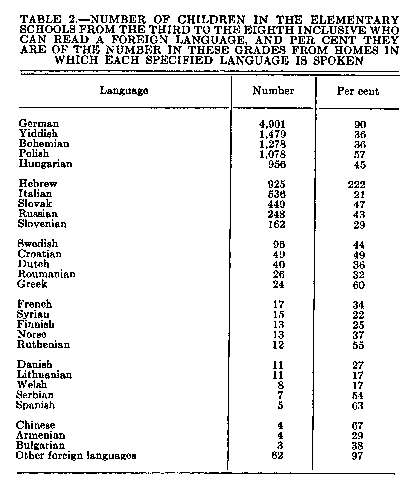
who can reed Hebrew to those who come from Hebrew-speaking families is more
than two to
one. Only a little over one-third of the Yiddish and Bohemian children can read
Yiddish or Bohemian, while over one-half of the Poles and nearly one-half of the
Hungarians can read their respective languages. Among the more im-
(30) -portant foreign groups the Italians show the smallest proportion who can read as well as speak their language.
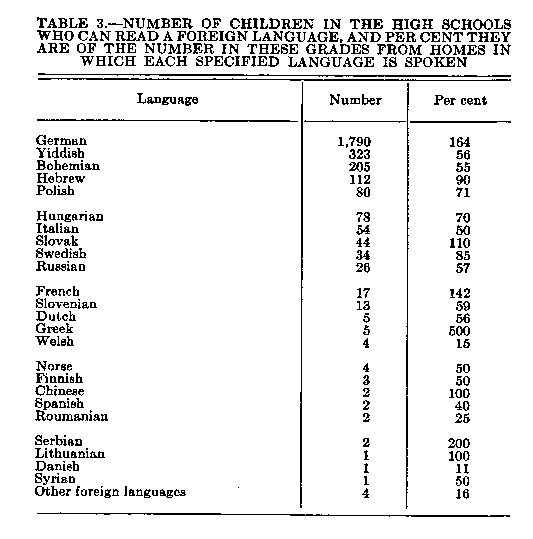
In the high schools one and two-fifths times as many students read German as there are pupils from German-speaking homes. This is due to the fact that German is offered as an elective in the high schools. Over half of the enrollment from Yiddish and Bohemian families
(31) and seven-tenths from Polish and Hungarian families read the language of their parents. The distribution is shown in detail in Table 3. It is to be noted that the percentage figures of the lower part of this table are of little significance on account of the small numbers involved.
FOREIGN LANGUAGE TEACHING IN PAROCHIAL SCHOOLS
Data relating to private schools were secured only from those supported by the Lutherans and the Roman Catholics. The Lutherans have 15 schools, of which one is Slovak and the rest German. The Slovak school, enrolling 359 pupils, comprises but three grades, although it is proposed to open additional grades as soon as capable teachers for them can be secured. Eleven of the 14 German schools reported an attendance of 2,074 in all. The three from which date were not secured are small schools, but it is doubtless well within the actual figures to put the total, in round numbers, et 2,500. Nearly all of these schools have eight grad., and according to the reports of high school principals, they prepare their children well. The universal practice is to teach German one and a quarter hours a day throughout the eight grades. Part of this time is devoted to instruc-
(32) -tion in religion. All the pupils are able to read, write, and speak German easily when they graduate.
It was somewhat more difficult to secure information from the Catholic schools, but the figures hem presented are approximately correct, although in many cases they are probably too low. Of the 52 parochial schools from which data were obtained, 30 may be classed as foreign language schools. The church itself has no particular enthusiasm for these foreign language schools, enduring rather than fostering them, so that the quality of the work done depends on the interest and capacity of the group which each represents, rather than on any determined and standardized educational policy of the church as to foreign language work. This lack of a prevailing purpose and aim in this matter results in considerable disparity in the relative efficiency of the various schools. Table 4 shows the number of children enrolled in the foreign language Catholic schools.
The total enrollment in the Catholic schools is slightly over 28,000, so that the proportion of foreign-language-speaking children is nearly 60 per cent. This, including the 2,859 children in the German and Slovak Lutheran schools, gives a total of at least 20,000 foreign-language-speaking children in the parochial schools.
(33) Adding this number to the enrollment in the public schools gives a grand total of approximately 57,325 children from foreign-languages-peaking homes. Those from English-speaking homes enrolled in both public and parochial schools number approximately 50,000.
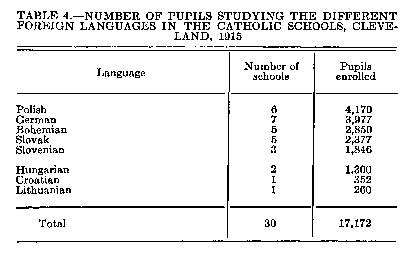
The language instruction in the parochial schools is primarily for religious purposes, and is often limited solely to that necessary for learning the catechism. In a few cases the priests are ardent nationalists, and make a real attempt to teach the language.
WIDE VARIATION IN DIFFERENT SCHOOLS
Children from foreign-language-speaking homes are found in every public school in Cleveland.
(34) Doan School, with four German children, three Swedes and one Russian among 795 pupils enrolled, is the least foreign, and Murray Hill, with 1,171 Italians, five Albanians (who also speak Italian), and one German in an enrollment of 1,348, is the most homogeneously foreign of the
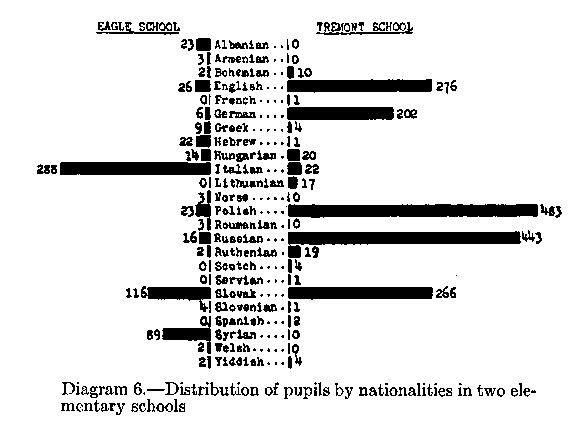
elementary schools. Both the percentage of foreign pupils and their
distribution by na-
tionality and language vary widely among the different schools, so that the
relation of racial and linguistic characteristics to teaching methods and school
management becomes a separate problem for each school. The comparison of the
(35) foreign distribution in two of the larger elementary schools, Eagle and Tremont, shown in Diagram 6, illustrates this point in a striking way. The Italians are the largest group in the Eagle School, constituting 44 per cent of the total number in the school, while in Tremont only one per cent are Italians. In Tremont the largest group is made up of Polish children, who constitute 27 per cent of the total, as against four per cent in Eagle.
Nor is the problem less complex if only a single school is considered. Such
schools as Eagle and Tremont are veritable melting-pots in which the ingredients
show no common linguistic or national elements. The proportions given vary also
within the schools in the different grades and from year to year.
SUMMARY
Approximately one-half the children in the elementary schools of Cleveland and one-third in the high schools are from homes in which some foreign language is spoken. The children of foreign parentage do not advance so rapidly through the grades as those of native parentage and they drop out much faster in the upper grades. Approximately one-third of the children of foreign parentage can read as well as
(36) speak a foreign language. About 20,000 children are receiving instruction in some foreign language in the parochial schools of the city. The distribution of pupils of foreign parentage varies widely in the different public schools and among the different grades in single schools.